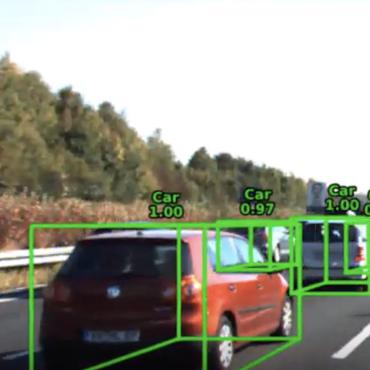3D Object Detection
585 papers with code • 55 benchmarks • 48 datasets
3D Object Detection is a task in computer vision where the goal is to identify and locate objects in a 3D environment based on their shape, location, and orientation. It involves detecting the presence of objects and determining their location in the 3D space in real-time. This task is crucial for applications such as autonomous vehicles, robotics, and augmented reality.
( Image credit: AVOD )
Libraries
Use these libraries to find 3D Object Detection models and implementationsSubtasks
Most implemented papers
YOLO9000: Better, Faster, Stronger
On the 156 classes not in COCO, YOLO9000 gets 16. 0 mAP.
Frustum PointNets for 3D Object Detection from RGB-D Data
In this work, we study 3D object detection from RGB-D data in both indoor and outdoor scenes.
VoxelNet: End-to-End Learning for Point Cloud Based 3D Object Detection
Accurate detection of objects in 3D point clouds is a central problem in many applications, such as autonomous navigation, housekeeping robots, and augmented/virtual reality.
PointPillars: Fast Encoders for Object Detection from Point Clouds
These benchmarks suggest that PointPillars is an appropriate encoding for object detection in point clouds.
nuScenes: A multimodal dataset for autonomous driving
Most autonomous vehicles, however, carry a combination of cameras and range sensors such as lidar and radar.
PointRCNN: 3D Object Proposal Generation and Detection from Point Cloud
In this paper, we propose PointRCNN for 3D object detection from raw point cloud.
Deep Hough Voting for 3D Object Detection in Point Clouds
Current 3D object detection methods are heavily influenced by 2D detectors.
PV-RCNN: Point-Voxel Feature Set Abstraction for 3D Object Detection
We present a novel and high-performance 3D object detection framework, named PointVoxel-RCNN (PV-RCNN), for accurate 3D object detection from point clouds.
3D Bounding Box Estimation Using Deep Learning and Geometry
In contrast to current techniques that only regress the 3D orientation of an object, our method first regresses relatively stable 3D object properties using a deep convolutional neural network and then combines these estimates with geometric constraints provided by a 2D object bounding box to produce a complete 3D bounding box.
Center-based 3D Object Detection and Tracking
Three-dimensional objects are commonly represented as 3D boxes in a point-cloud.
























































 KITTI
KITTI
 nuScenes
nuScenes
 ScanNet
ScanNet
 NYUv2
NYUv2
 SUN RGB-D
SUN RGB-D
 S3DIS
S3DIS
 Waymo Open Dataset
Waymo Open Dataset
 Argoverse
Argoverse
 Argoverse 2
Argoverse 2
 ONCE
ONCE



